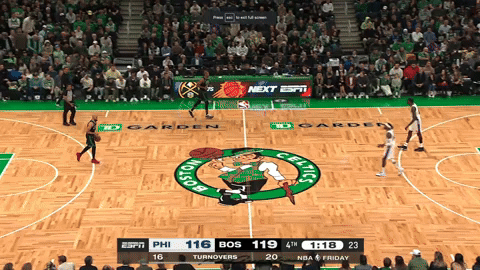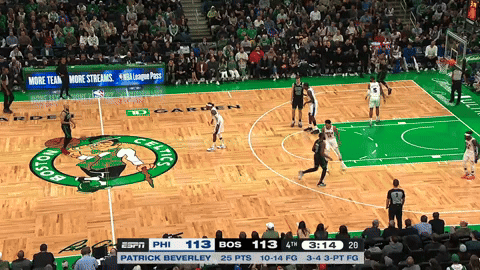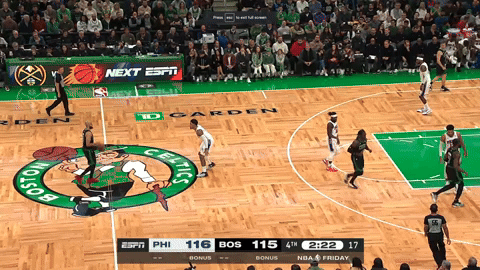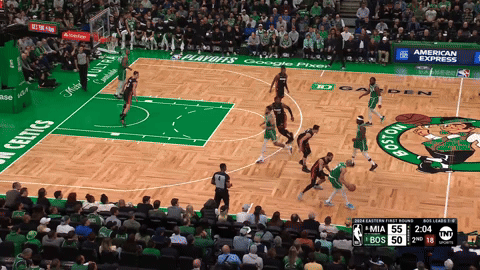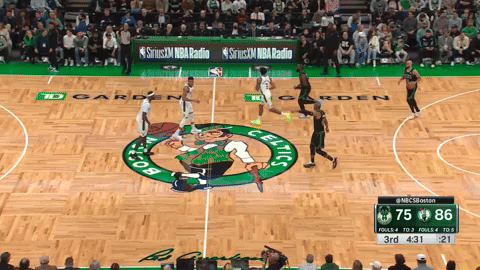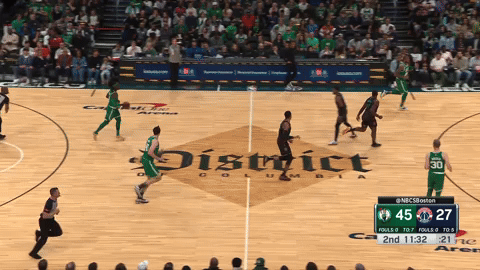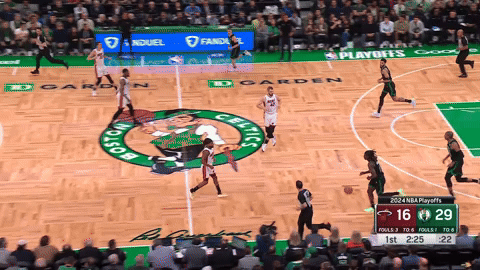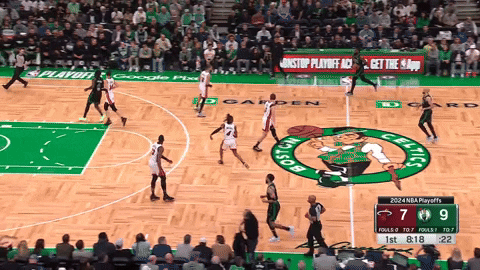A scouting report on the Cleveland Cavaliers ahead of the Celtics 2nd round series.
These scouting reports are officially a tradition.
It’s official: the Boston Celtics will face the Cleveland Cavaliers in the second round of the Eastern Conference Playoffs. Donovan Mitchell helped lead his team through a tough seven-game series against a young and plucky Orlando Magic team. Now, the Cavs have until Tuesday to work on their game plan for approaching the Celtics.
In what has become tradition, let’s examine what makes the Cavaliers tick on both sides of the floor so we know what to expect come opening tip.
Cleveland: By the numbers
Cleveland ended the regular season ranked 16th in the league for offensive rating, averaging 114.7 points per 100 possessions. In average scoring through the season, they trailed the Celtics by 7.5 points per 100.
On defense, the Cavaliers ranked 7th in the league for defensive rating, holding their opponents to 112.1 points per 100. That put them 12th in the NBA for Net Rating, with a +2.5. It's not bad, but it's a far cry from Boston’s +11.7.
Those numbers have taken a dip during the postseason. Over their first six games (the tracking data hadn’t updated for the seventh game as I wrote this), the Cavaliers sit 15th among the playoff teams for offensive rating, averaging 98.9 points per 100. They’re fairing far better on the defensive end, though, sitting fourth—one spot behind Boston—in defensive rating, holding teams to 107 points.
Cleveland’s offensive struggles during the postseason should be concerning for them heading into a series against the Celtics. Boston held the Miami Heat to under 100 points on four occasions; they will have no problem throttling Cleveland’s offense if it shows signs of stuttering out the gate.
When looking at this from a top-down view, the Celtics are the dominant team on both sides of the floor. They’re scoring more freely and playing a tougher brand of defense. The Cavaliers must elevate their level of play to make this a competitive series.
Let’s start peeling off some additional layers. All data, unless stated otherwise, is courtesy of Cleaning The Glass. I have stuck with regular-season data because it has a bigger sample size and paints a clearer picture.
Offensive Shot location frequency
This is where Cleveland’s offense is coming from and how frequently they look to attack those spots. The higher the league ranking, the more frequently the Cavaliers are attacking those spots vs. other teams in the league.
Around the rim - 35.4%, 5th in the league
Mid-Range - 25.6%, 30st in the league
Short mid-range - 19.6%, 28th in the league
Long mid-range - 6.1%, 28th in the league
3-Point range - 39%, 7th in the league
Non-corner 3’s - 29%, 6th in the league
Corner 3 - 10%, 11 in the league
Offensive Shot location accuracy
This is how accurately a team is shooting from each location on the court - the higher the league ranking, the better the Cavaliers are at scoring in those areas.
Around the rim - 65.5%, 18th in the league
Mid-Range - 44.2%, 13th in the league
Short mid-range - 43.9%, 14th in the league
Long mid-range, 45%, 7th in the league
3-Point range - 37.1%, 15th in the league
Non-Corner 3’s - 37%, 11th in the league
Corner 3 - 37.4%, 23rd in the league
Putting that into context
Cleveland has no problem in getting to the rim. They’re smart with how they space the floor. When both are on the court, Jarrett Allen is the rim-runner, and Evan Mobley works out of the corner. That allows Cleveland the space they need to pressure the rim at will.
However, getting to the rim and finishing at the rim are two different things. They’re one of the best teams in the NBA at generating shot attempts within 4 feet of the basket but are near the bottom 10 in their ability to convert those looks.
What make’s it tougher for the Cavaliers, is that they’re not a big mid-range shooting team — not even in terms of floaters. They’re in the bottom 3 of the NBA for short and long mid-range attempts, although they do find reasonable success when they turn to those shots.
Cleveland does like to shoot the three. They’re 7th in the league for perimeter shots attempted. They’re a middling team in terms of conversion rate, sitting 15th in the NBA. Don’t let that fool you, though, because when you take away their corner attempts, they’re a borderline top-10 perimeter offense. A lot of those shots are coming from Max Strus and Donovan Mitchell — we will get into matchups later.
So, what does this mean for the Celtics? Joe Mazzulla will likely be looking to limit the Cavaliers’ ability to get downhill. The more the Celtics can protect and take away the rim, the tougher Cleveland will find it to generate offense. Given the Cavaliers’ penchant for Morey Ball, finding ways to force them into the mid-range and living with them taking those shots will be ideal.
As such, I would expect some high pick-up points with solid pinching below the free-throw line. A switching system would also put the Cavaliers into isolation plays, limiting their ability to flow into secondary or tertiary actions.
Defensive shot location frequency
This is where opposing teams look to generate their offense against the Cavaliers’ defense - the lower the league ranking, the more frequently teams attack those spots.
Around the rim - 33.6%, 18th in the league
Mid-range - 31.2%, 14th in the league
Short mid-rage - 22.2%, 15th in the league
Long mid-range - 9.1%, 21st in the league
3-Point range - 35.1%, 8th in the league
Non-Corner 3’s - 25%, 4th in the league
Corner 3 - 10.2%, 22nd in the league
Defensive shot location success rate
This is where opposing teams find success on offense - the lower the league ranking, the more successful teams are from those spots.
Around the rim - 62.8%, 3rd in the league
Mid-range - 41.6%, 6th in the league
Short mid-rage - 42.1%, 7th in the league
Long mid-range - 40.3%, 8th in the league
3-Point range - 37.7%, 21st in the league
Non-Corner 3’s - 39.9%, 20th in the league
Corner 3 - 36.8%, 19th in the league
Putting that into context
Generating offense around the Cavaliers’ rim is a difficult task. Their enormous frontcourt limits easy looks in the restricted area. Interestingly, J.B. Bickerstaff has his team setting traps. They allow a large amount of offense at their rim, sitting 18th in the NBA for shots within their restricted area. Yet they’re 3rd for rim protection. They know their strengths and have no problem funneling teams toward their shot blockers.
Part of creating that funnel is being a tough mid-range defense. You've got to take away one or two-dribble pull-ups when shooters are attacking close-outs. That’s how you force them to drive or force a re-direct for a stampede cut or some secondary actions.
It also helps that the Cavaliers have a reliable perimeter defense in terms of denying three-point attempts. Opposing teams are only generating 35.1% of their offense on the perimeter. The problem Cleveland has. is that when opposing teams do generate perimeter offense, they have a hard time impacting the shot, with them being a bottom-10 team in 3DFG%.
What does this mean for the Celtics? It would make sense for Boston to stick to their usual game plan. If the Cavs are happy letting teams get downhill, Mazzulla will likely task his team with running a drive-and-kick-heavy game. Cleveland’s struggles when guarding the corner three could lead to Jrue Holiday having a big series in terms of scoring and shot making.
Of course, it makes sense for Boston to test Cleveland’s rim protection, too — after all, Jayson Tatum and Jaylen Brown are two of the best slashing wings in the NBA and have enough counters to keep the defensive bigs on their toes.
Setting the Stage for the Celtics: Cook on the perimeter
If the Cavaliers struggle to impact, limit, and defend the three-point line, they will have a tough time guarding the Celtics. Mazzulla likes his team to play math games where possible. Three is more valuable than two, especially when the team you’re facing struggles to make three at a high clip and relies on rim pressure to generate consistent offense.
Expecting Boston to cook off the dribble is likely too much. This is the second round of the playoffs; adjustments will quickly punish whoever decides that going iso is the best bet. Instead, sticking to actions that have worked during the season would be the smarter option.
Fortunately, if you’ve been subscribed to this newsletter for a while, we’ve already looked at the actions we’re most likely to see. Nevertheless, it’s always worth going back over them.
Firstly, I just want to note that cooking on the perimeter doesn’t necessarily mean generating open threes. It could mean creating space to crack teams off the dribble or bully your way through a mismatch. For Boston, their perimeter actions are the engine that propels everything else.
This action is called “Chest.” It’s a ghost screen that flows into a flare screen. The ghost screen causes confusion with the defense’s switching principles, while the flare screen creates space as the off-ball defender chases over the screener. This action has consistently yielded good results for the Celtics when running for Brown.
Brown’s ability to shoot off the catch, drive the lane, counter the defense in the mid-range, and make reads one or two passes away make him the ideal candidate to be the focal point of this set. I chose the above clip because it shows how the action can create opportunities to cut off the flare screen and trigger a defensive rotation.
Cleveland may be willing to let teams attack the rim, but it’s doubtful they would be comfortable with Brown cutting like this clip. Once the defense rotates, you’re at an advantage. Kick the rock, move it around, find gaps, and attack.
If the defense navigates the screening sequence well, Brown can counter by coming off a re-screen and getting into his mid-range game.
If the defense looks to hedge or blitz the flare screen receiver, the screener can slip the defense and attack the space in the mid-range. And, of course, if the space is there, the screen receiver can fire away from deep off the catch.
One simple action can lead to a multitude of outcomes. That’s where the Celtics excel. They have options and answers for however, teams look to limit their offense, especially in sets like this, where there’s motion on the entry pass.
Another option for the Celtics would be running some more ‘Oklahoma,’ which would use their desire to play with tempo by getting into early offensive sets.
Oklahoma is essentially a stagger screen where the first screener screens for the second screener after the ball-handler has come off the stagger. Brown is the screen receiver in the above clip, flaring off Jrue Holiday’s screen. The play is quick, it misdirects the defense as they focus on the ball-handler and the threat he poses off the dribble, allowing the screening action to occur.
Another version of Oklahoma is known as “Twirl.” It’s essentially the same movement but with staggered down screens set on the wing. Mazzulla used “Twirl” actions a lot during his rookie season, however, they’ve rarely featured this year.
Another form of ‘Twirl’ can be when the initial screen receiver curls the screen and flows into ‘America’s Play’ — Screen the screener.
These three actions are just the tip of the iceberg when it comes how the Celtics can generate offense on the perimeter while taking advantage of the Cavaliers’ limited perimeter defense. I’m certain we will be looking at some new angles over the next few games.
***2nd round flash sale***
Ending tomorrow, I’m offering paid subscriptions to the newsletter at a 20% discount for your first year — both monthly and yearly plans. That will cover you throughout the playoffs, the offseason and all of the 2024-25 regular season.
For just $4 per month or $40 for the year, you will get:
Scouting reports such as this one
X’s and O’s breakdowns
Cross-over discussions with other writers from around the league
Analysis posts
Thoughts on news, rumors, and trending topics
And the occasional editorial.
I’m always looking to add more to the offering, too, and I am working towards higher consistency and volume ahead of next season.
Setting the Stage for the Celtics: Attacking the wings
Without Porzingis in the rotation, the Celtics could look to move away from generating offense in ‘delay’ actions. In their game five win over the Miami Heat, Boston ran more offense down the wings, especially with 21 and/or chase actions.
Why does attacking the wings make sense for Boston?
The Cavs struggle to impact corner threes
The Celtics have the spacing and shooting to be effective when attacking the wings
Empty corner actions remove help defense that can allow a shooter to rotate over
Hauser is one of the best movement shooting specialists in the NBA.
If the Celtics can flow into EPA’s (Early Pitch Ahead) actions, they should be able to pressure Cleveland’s defense before it sets. Brown, Tatum, Holiday, White, Horford and Hauser have all proven capable of attacking closeouts off the dribble. Payton Pritchard’s pace and tempo allow him to cook in the open court.
When Porzingis is on the floor, it makes sense to use him as a hub above the perimeter. Without him, leaning into athleticism and shooting on the Celtics roster could be what makes the difference.
Offensive Shot location frequency
This is where Boston’s offense is coming from and how frequently they look to attack those spots. The higher the league ranking, the more frequently the Celtics are attacking those spots vs. other teams in the league.
Around the rim - 29.1%, 26th in the league
Mid-Range - 27.1%, 29th in the league
Short mid-range - 18%, 29th in the league
Long mid-range - 9.1%, 14th in the league
3-Point range - 43.7%, 1st in the league
Non-corner 3’s - 33.8%, 1st in the league
Corner 3 - 9.9%, 12th in the league
Offensive Shot location accuracy
This is how accurately a team is shooting from each location on the court - the higher the league ranking, the better the Celtics are at scoring in those areas.
Around the rim - 70.5%, 4th in the league
Mid-Range - 44.6%, 12th in the league
Short mid-range - 44.7%, 13th in the league
Long mid-range, 44.2%, 9th in the league
3-Point range - 39.3%, 2nd in the league
Non-Corner 3’s - 38.1%, 8th in the league
Corner 3 - 43.6%, 1st in the league
Given how the Celtics offense is so heavily predicated on the perimeter, running actions on the wing should lean into the team’s overall gravity. Bickerstaff will want his team to do whatever they can to limit easy looks — both in the corners and around the horn. The more the Celtics attack those angles at pace, the more Cleveland’s defense is going to be manipulated and their rim protection compromised for secondary cuts or actions.
Hey, you! Are you subscribed to the Celtics Chronicle? If not, let’s change that, just drop your email below and hit that green button.
Setting the Stage for the Celtics: Dealing with rim-pressure
Defensive shot location frequency
This is where opposing teams look to generate their offense against Boston’s defense - the lower the league ranking, the more frequently teams are attacking those spots.
Around the rim - 29%, 3rd in the league
Mid-range - 33.7%, 26th in the league
Short mid-rage - 23.6%, 22nd in the league
Long mid-range - 10.1%, 27th in the league
3-Point range - 37.3%, 20th in the league
Non-Corner 3’s - 8.1%, 4th in the league
Corner 3 - 29.2%, 28th in the league
Defensive shot location success rate
This is where opposing teams find success on offense - the lower the league ranking, the more successful teams are from those spots.
Around the rim - 63.6%, 5th in the league
Mid-range - 42.8%, 13th in the league
Short mid-rage - 43.2%, 13th in the league
Long mid-range - 42%, 12th in the league
3-Point range - 36.1%, 6th in the league
Non-Corner 3’s - 36.4%, 2nd in the league
Corner 3 - 36%, 13th in the league
Without Porzingis in the rotation, the Celtics rim protection will take a major hit. Yes, on paper, they’re one of the better defensive teams in the league within four feet of the basket. Yet, without their star big man, that effectiveness could take a dip.
As such, Mazzulla’s team could tweak their defensive system and go back to a more pressure-based defense. You don’t want Mitchell or Garland getting hot off the dribble, so switching and cross-matching could be the answer. By cross-matching, you’re also limiting opposing bigs' opportunities to get downhill as a role man.
For someone like Allen, if you take away his ability to roll or cut to the rim, you’re drastically reducing his effectiveness on offense. Mobley will require some additional attention as he can shoot the ball from all three levels.
If Mazzulla does opt to stick with a drop defense, then Horford must lean into his ability to cut off angles and read the offense's game plan. He is at his best when rotating early and forcing opponents toward the baseline or to their weaker hand. He’s also strong enough to adjust his pick-up point and tag rollers in the mid-post — again to limit their effectiveness around the rim.
Luke Kornet will also have a big role to play. He might not be as mobile as Porzignis, but his positioning and size make him a good option for containing ball-handlers as they penetrate off the PnR. Kornet can also provide resistance in the paint, although he’s not the most physical of defenders. Nevertheless, his size can pose a problem and will allow Mazzulla to keep pace with Bickerstaff when he goes big.
Celtics vs. Cavs: The matchups
A lot depends on how Mazzulla opts to deal with his starting unit…Does he go double-big to counter the Heat’s size? Or does he stick with a single-big rotation to begin and end games?
My personal preference is to stick with single-big, at least for now. It allows the Celtics more fluidity on offense and keeps the best players on the floor. As such, one potential matchup could look like this:
White - Garland
Jrue - Allen (if healthy)
Brown - Mitchell
Tatum - Strus
Horford - Mobley
This matchup would assume that Boston is switching 1-through-5 and would put Holiday on Allen to cross-match the most dangerous big and limit Mitchell or Garland’s effectiveness as PnR creators and/or scorers. Of course, Tatum may be better suited to guard Mobley due to his size, length, and versatility as a help defender.
Who knows, I could be totally off base here. I’m just throwing out one option that could potentially work. My thought process is about limiting Allen’s effectiveness as a rim-runner while also containing the scoring and playmaking of Cleveland’s backcourt.
Let me know your thoughts on this in the comments section!
Three questions I have heading into the game
How healthy are Jarrett Allen and Donovan Mitchell?
Allen sat out Cleveland’s game seven win over the Orlando Magic on Sunday. That wouldn’t happen if he were nearly fully healthy. He is one of the Cavs’ best weapons in the upcoming series against Boston. If he’s not near his best, that seriously hurts their chances of pushing the series into the deep waters. Mitchell hasn’t looked himself in the past 2 games, either. Yes, he’s had his scoring bursts, but that is more down to him being force-fed on offense than it is him being at his best. How long this series goes for will be tied to how healthy these two stars are.
Will Mazzulla switch up his rotation?
Could this be a series for Xavier Tillman? Is Queta’s size and motor a good counter to Allen and Mobley? If so, does that mean Kornet is benched? Or will Hauser see his role shrink? Maybe it’s Pritchard? Or maybe Mazzulla can extend his rotation and lower the minutes distribution for the bench unit. There’s a lot of options at his disposal. He’s shown that he’s not afraid to be different and make big calls — and that’s exactly what’s needed — especially against a big Cavs team with Porzingis sidelined.
Staying glued to Strus and Dean Wade
The Celtics know all too well how dangerous Cleveland’s rotation guys can be. Wade cooked them earlier this year. Strus is a player that’s haunted the roster for years. Finding ways to limit their impact without over-helping and leaving gaps elsewhere will be essential. Under no circumstances do we want another collapse down the stretch with Wade leading the charge. Can the Celtics figure out how to contain the role players? Or will Mitchell’s gravity create some openings that Bickerstaff can look to exploit throughout the series?
Want more thoughts on this series? Show love to the YouTube channel
Wrapping it up
It’s easy to look at Cleveland’s performances against the Magic and assume they’re going to be an easy out. That’s not necessarily the case. Yes, the Celtics are the better team. Yes, Cleveland is battered and bruised. And yes, this shouldn’t be a long series.
Cleveland can still test the Celtics, though. They have an All-Star guard in Mitchell. Garland is fantastic. Strus is a flamethrower. Their frontcourt size is worrying. And their struggles against the Magic may have been due to Orlando’s physicality and desire to muck things up — we know how that goes after years of playing the Heat!
After beating the Heat, getting that task over with nice and early, and having some valuable rest days, I’m backing the Celtics to get this done in five or six games. If Allen is out or Mitchell isn’t near 100%, the series might be shorter than that. Still, I expect this to be a good test for the Celtics.
As always, I’m excited to see the series get underway and for the Celtics to get back on the floor.
If you’re new here, thanks for stopping by! I hope you choose to stick around. If you’re a subscriber, I appreciate the support and your choosing to rock with the newsletter. Catch everyone tomorrow.


